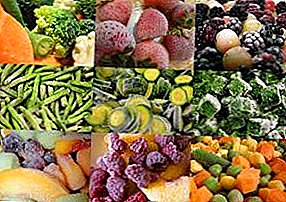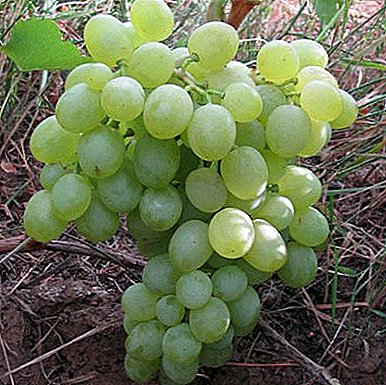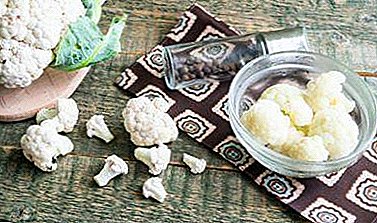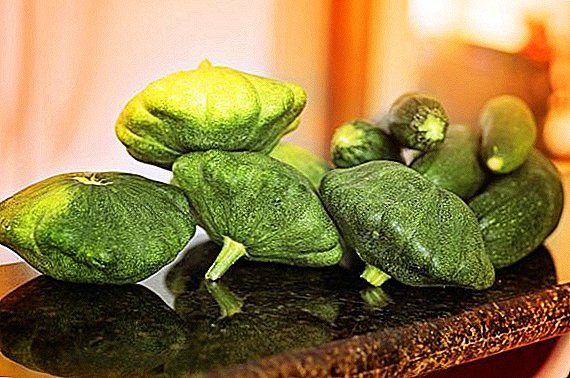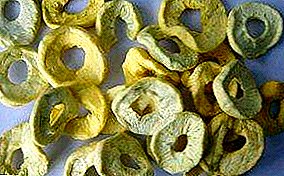
Only healthy vegetables are suitable for drying; late fees are more suitable for this purpose than early ones. For drying take only those parts that go into food; pre-cleaned from the ground, then washed thoroughly. Fragrant plants are bundled in non-large bunches. Before drying, deciduous vegetables are immersed in brine for 15 minutes, then put them in wicker baskets, immersed in warm water, which is then brought to a boil. The readiness of vegetables can be judged by their weight; well dried, they lose from 80 to 90% of their normal weight.
Dried vegetables are stored in a dry place in wooden boxes. Before eating, dried vegetables should be soaked in water (cold - in the summer, warm - in the winter), until they take a natural volume. For home use, a wide variety of vegetables are dried, drying is carried out as they mature; the fresher the vegetables, the better for drying. Steaming vegetables should be made in any kind of dishes, just to be able to heat the water in it to boil; water for this must be clean. The following vegetables are scalded: potatoes, ground pears, all kinds of cabbage, peas, beans, turnips, turnips, tomatoes, carrots and beets, while the rest are not scalded.
Vegetables prepared for drying are scattered on the screens, sieves in an even thin layer; undried vegetables easily grow moldy. Harvesting of greenery is carried out periodically, as the leaves grow. When a plant has a seed stem, the leaves are not robbed, for at this time they are rough and tasteless. If the greens are small enough, it is not crushed, but if the leaves are large, then they should be cut into smaller pieces.
When drying, young nettle gives the best product, it is used for borsch with tomato, while it is broken as it develops, new greenery will constantly appear on the spot of torn nettle. Spinach is cultivated in the garden and is harvested when the leaves are young and fresh, harvested in the same way as nettles. Spinach is dried with whole leaves. Sorrel grows in a wild state, and plants are gathered in the spring, later it will throw away the seed stalks and harden. Dill - seasoning in soups, borscht and other dishes, which he gives flavor.
Dill is harvested by plucking green twigs as they grow. Flowering plants do not stop the collection of dill branches for drying. Parsley leaves are picked from the root of the parsley, the tops of the side large leaves of parsley are cut off, with a small amount from each plant, so as not to interfere with the nutrition and development of the root. A more significant collection of leaves is already when cleaning the root.
Parsley root should be thick, as thin will give a lot of garbage; the skin is not scraped off, and the root is well washed. Celery leaves are sometimes harvested from celery root, like parsley leaves. Deciduous celery gives the best greens for drying. Celery root gives a delicious and nutritious product and strong flavor. White cabbage is dried in fresh and pickled form. When drying fresh cabbage, cabbages are cleaned from bad, spoiled foxes. Its leaves are dried whole. Before drying, the cabbage needs to be boiled for a few minutes. Properly dried cabbage should retain its inherent color. Before drying, sauerkraut is squeezed from the liquid. The stronger the cabbage will be squeezed out, the sooner it will dry. Savoy cabbage is processed fresh, like white cabbage.When dried, the cauliflower is scalded and dried at a moderate temperature.Only the head is dried, the rest It is discarded. The denser the head of a color cap, the higher its quality, it dries at a moderate temperature. The leek is most suitable for drying. Onions must be removed from the bed when it has reached full maturity (green has dried) dried in the air and then in a heated room.When drying, the onion is crumbled and cut off the dried top, as well as the roots with thin slices of meat and onion and divided into several parts. The rutabaga is dried at a moderate temperature, and the dry retains its qualities not for long (no more than 5 - 6 months). Turnip is dried the same way as swede. Horseradish for drying is crushed on a plate, dried is pounded or ground into powder.
To prepare dry green peas, the pods are plucked when the peas are green and sweet. If the peas began to turn white, then they are no longer suitable for drying. The pods of peas are robbed at the beginning of the day, and they should be cut off carefully. From the beds intended for receiving seeds, pods do not rob. Collected pods immediately shelling and dried grains are allowed to be recycled. Husk peas scald and dried. The peas older and larger, the longer it is scalded and vice versa. Scalded peas immediately immersed in cold water for rapid cooling, this fixes the green color. Properly cooked peas are dark green in color, have a wrinkled shape, aroma and pleasant, sweet taste, undercooked peas come out light green, and the digested ones have brown dots.
Asparagus, intended for drying, cut into equal parts, put them on a string (not too tightly to each other) and hang in a warm oven; during drying it must be turned over. Asparagus is stored in glass jars, before use, it is wet in cold water and boiled in it. The hard parts of the asparagus are cut before drying.
Tomatoes are scalded before drying for a few seconds; skin is removed; drying lasts a long time. The clean and dry fruits of the tomatoes are cut into two or four pieces, and the seeds are removed. Not quite ripe fruits are selected for drying; whole tomatoes are not dried. The cut tomatoes are first dried in air, then they are passed through a very fine sieve, and the mashed potatoes thus obtained are again exposed to the sun. It should be noted that only tomatoes are used for mashed potatoes, which will not give a good enough product when dried in the form of pieces, which, with good drying, retain their natural red color. For this purpose, they are dried first in the sun, and then dried in an oven. Tomatoes are ready when the liquid is not felt when pressure is applied to them. To better preserve the mashed potatoes, the tomato is salted (1 h. Of salt for 16 hours of mashed potatoes).
For drying potatoes take mainly table varieties. Peeled potatoes are cut first into slices, and then these last into sticks. Before drying, the potatoes are boiled and immersed in Ki-heels for three minutes, so that the potatoes soften a little, but the dampish taste is preserved. The best product for drying is obtained from young potatoes, which are not peeled, but washed with cold water; then immerse it in boiling water for five to six minutes. Dried potatoes for a long time retains all the qualities of raw.
The best in quality for drying carrot variety - without a yellow heart-fault, a beautiful reddish color and a sweet taste; obvarkoy fixed its color. Pasternak is dried in the same way as celery. In dry parsnips should remain white color and flavor. As for the dignity of the beet, it is in its color; The best beet products, both in appearance and quality, are obtained from varieties with dark red flesh without any white stripes. Beets when drying requires a high temperature. The best varieties for drying swede are round-shaped, with possibly thin skin, yellow and tender sweet meat. Peel the rutabaga to clean to the very yellow flesh, while drying it is necessary to burn it. Well dried swede is a beautiful yellow color with a pleasant smell.
Continue reading: drying mushrooms at home. How to dry mushrooms at home? And you can learn more about the orchard in a special section of our site: //rusfermer.net/sad/plodoviy


